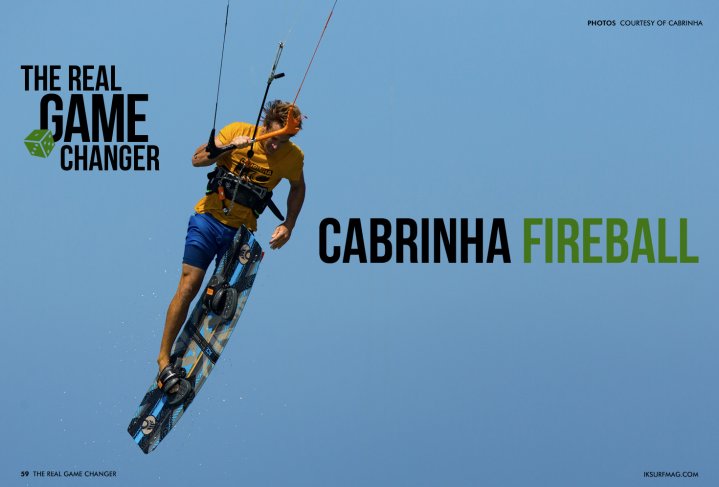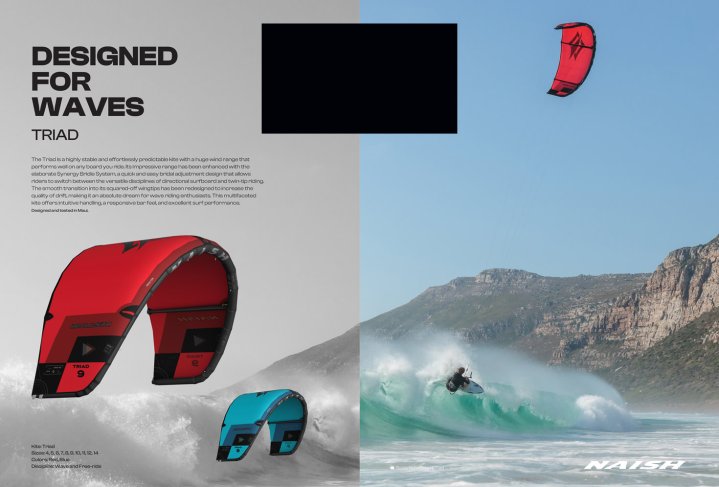
The Real Game Changer - Cabrinha
Issue 59 / Thu 13th Oct, 2016
The Cabrinha Fireball was the first “game changer”, what do you make of it though? We asked Pete Cabrinha the questions you put on social media, do his responses convince you to get on board?
The first in a torrent of new innovations for 2017, the Fireball has taken years to develop and aims to change the way we connect to our kites. The goal is to reduce the force on your body as you ride, while allowing you to have a 360 degree attachment point rather than a fixed hook and a loop. You can read our test of the new Fireball in Issue 58 HERE. We sat down with Pete Cabrinha to ask some of our own questions about the new system as well as some of the concerns you voiced on social media…
The launch was met with some scepticism as well as some real praise, were you prepared for the Fireball to polarise opinions in that way?
Pete Cabrinha: Yes. I fully anticipated the scepticism. Anytime you depart from something that is considered a standard the responsibility is on you to prove that what you are offering is, in fact, better. I knew there would be polarised opinions on Fireball and I welcomed the controversy. Controversy is really just another form of conversation. Controversy sparks conversation, and the more people discuss something the facts eventually rise to the top. By having people talk about Fireball, analysing it and comparing it to a loop system they all end up with the same conclusion. Fireball offers a more fluid and friction-free method to connect to your kite.
One of the biggest fears in the comments online was its lack of compatibility with other systems. Will you be sharing the patents or is the Fireball something we will only ever see on Cabrinha bars?
Regarding the lack of compatibility; kitesurfing is a very personal experience. Once you connect to your kite and hit the water, it’s just you and your equipment. A simple fact is that more than 90% of riders never swap their gear with another rider. For the tiny number of people who do…they will need to use a Fireball spreader bar as well.
That being said, Fireball has quickly risen to be the preferred method of connection in the Cabrinha offering. There are already thousands of units on the water, and the numbers are rapidly growing. We plan to offer the system to harness, accessory, and other kite brands soon. Details on this will be forthcoming.
What are the benefits of the system for the rider?
This first and foremost benefit is a fluid and friction-free connection that is much closer to the core than a traditional hook and loop system. It is non-binding. It provides a 360-degree rotation. It has an Autolocking gate which secures the ball in place with only one finger. The fact that the socket is closer to your core means that it reduces the leverage (and force) of the bar against your body. Up to 50% less force than some hook and loop systems. Fireball is safe and secure, and the quick release can reconnect in less than 3 seconds. It’s smaller and lighter with a modern minimalist design.
Our testers really enjoyed Fireball; it seems when people try it they like it, are you running demo opportunities globally to persuade people to use it?
This is one product that MUST be tested to fully appreciate the claims that we are making. Personally, I am someone that does not buy into marketing hype too quickly so I would understand if anyone wants to reserve judgement until they’ve tested it. We usually ask riders first to go for a spin with their current loop system and then immediately follow up with a Fireball test. Demos and rider testimony have been Fireball’s greatest marketing.
Are there particular styles of kiting that it is more suited to?
Fireball is aimed at the 80+% of riders who ride predominantly hooked. This is basically the largest group of kitesurfers so you could say that this is really for anyone. Surfers will love the fluidity, especially anytime they are in extreme body positions where the kite is pulling from acute angles to the body. Toeside for example. It is also ideal for hooked in kite loops and for any type of big air freestyle.
What was it about the sliding bar systems that you didn’t like that lead you to design the Fireball? It offers that similar freedom of movement as an end goal after all.
There are at least three main differences between Fireball and a sliding system.
- Sliding systems are great for some types of riding, specifically when surfing. However, even while surfing you are getting airs, climbing large white-water, or just heading on long tacks to get yourself back upwind to the peak. Sliding systems are also not ideal for all types of airs. There are many times when you want the pull of the kite to be consistent and centred on your core. Fireball allows for this while giving you the unhindered freedom of a ball and socket connection.
- The socket connection with Autolock™ allows for an easy one-handed connection and disconnection. This is also great for a situation where you need to hand off a kite to another rider while the kite is already in the sky. You don't need to release and reconnect the chicken with Fireball.
- Fireball is an integrated system. This means that everything about the control system and the spreader that it’s connected to is designed together as a single system. This is especially important when it comes to security, we have precise control over the exact point where the kite connects and releases from the rider.
Unhooking was a huge topic in the discussions online, you can unhook with it, and do you think the marketing should have reflected that aspect a little more?
It’s true that you can unhook with Fireball, but we did not want to over emphasise this feature just yet. The fact is this: Unhooking with Fireball is incredibly easy. But with the socket being a much smaller target for re-hooking, the unhooking aspect is mainly geared for intermediate to advanced unhooking riders. The second point is that it is not set up from the factory with a suicide release. The second generation of Fireball will have a specially designed unhooking feature that will be a top-level unhooking system.
The beauty of Fireball for unhooking is that while you are unhooked, you only have a small QR and ball below the bar… there is no loop to catch on anything. This is something our freestyle riders are excited about.
Even riders who don’t unhook always aspire to do simple moves like raleys, will you be developing a more unhooking friendly version in the future, or pointing those riders to your other bar systems?
In the transition period we still offer our Quickloop, which is perhaps the best system for unhooked freestyle.
What was the biggest challenge in the development of the product, there must have been an immense amount of tooling?
Fireball went through many different configurations and directions. We made incredible use of different 3D printing and rapid prototyping technologies to get through this stage of the process. In the early stages of development, we were chasing a ball and socket connection whereby the spreader bar could be used for either a loop or a Fireball system.
We had some interesting concepts, but in each case, it was a design compromise for both the Fireball and the loop. It wasn’t until we decided to make Fireball a dedicated ball and socket system that all of the current features were fully realised and unlocked. Designing a no compromise connection from the ground up allowed us to make important performance gains across the board.
Did you employ any new technologies in the development process?
We used many modern prototyping techniques in the development but relatively traditional techniques in production… for example; plastic injection moulding and cast stainless steel. However, it was this all-new ball and socket concept that made us work with a very non-traditional type of loading. One of the most important features, the Autolock™ gate, was also one of the most demanding design elements due to the way the ball loads in the socket and stays secure without creating friction or binding.
What is the future for Fireball, where do you see it headed and how do you see it developing within the market?
Fireball V.1 is just the beginning of our next generation connection system. We plan to lock in individual specifications for the time being so that we can build onto this modular system while maintaining backwards compatibility. For example, the ball will stay the same size so that any new spreader bar configurations will remain compatible.
Another feature unique to Fireball is that the lower section (the ball) of the connection separates from the top section (the quick release). If you think about this for a second, it's easy to imagine that a rider could have different types of ball and socket connections that are personally geared for their particular type of riding. Whether it be surfing, freestyle, foil boarding, racing, etc. We now have an ecosystem that we can feed into well into the future.
Videos
By Rou Chater
Rou has been kiting since the sports inception and has been working as an editor and tester for magazines since 2004. He started IKSURFMAG with his brother in 2006 and has tested hundreds of different kites and travelled all over the world to kitesurf. He's a walking encyclopedia of all things kite and is just as passionate about the sport today as he was when he first started!

















